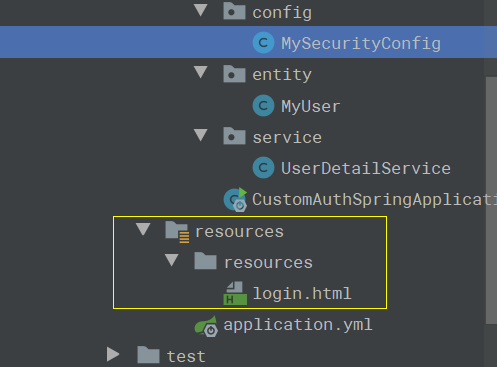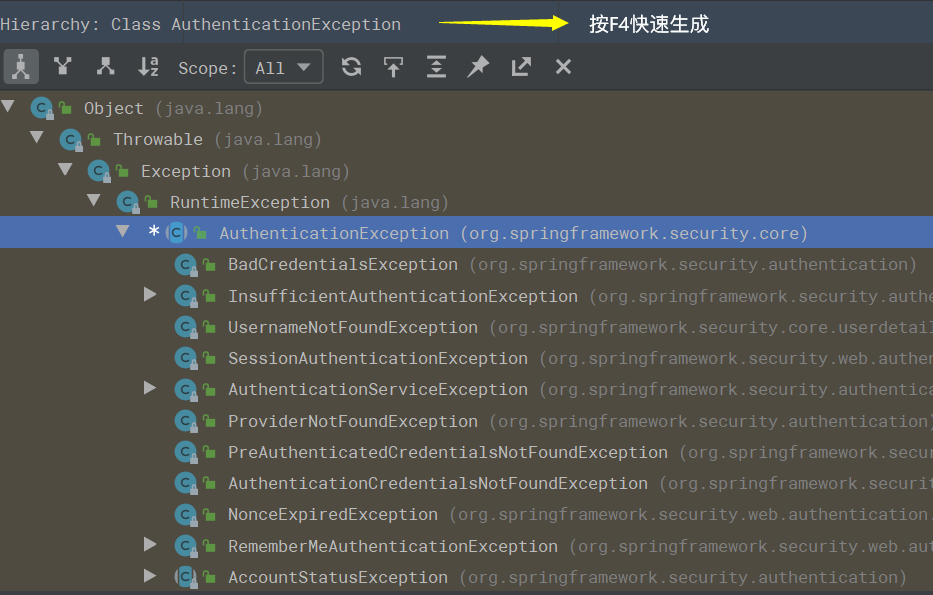- 自定义认证过程 自定义认证的过程需要实现Spring Security提供的UserDetailService接口 ,源码如下:
public interface UserDetailsService {
UserDetails loadUserByUsername(String username) throws UsernameNotFoundException;
}
loadUserByUsername方法返回一个UserDetail对象,该对象也是一个接口,包含一些用于描述用户信息的方法,源码如下:
public interface UserDetails extends Serializable {
// 获取用户包含的权限,返回权限集合,权限是一个继承了GrantedAuthority的对象;
Collection extends GrantedAuthority> getAuthorities();
// 获取密码
String getPassword();
// 获取账号/用户名
String getUsername();
// 账户是否过期
boolean isAccountNonExpired();
//账户是否被锁定
boolean isAccountNonLocked();
//用户凭证是否过期
boolean isCredentialsNonExpired();
//用户是否可用
boolean isEnabled();
}
- 创建实现自定义认证接口的类:
@Configuration
public class UserDetailService implements UserDetailsService {
@Autowired
private PasswordEncoder passwordEncoder;
@Override
public UserDetails loadUserByUsername(String username) throws UsernameNotFoundException {
// 模拟一个用户,实际项目中应为: 根据用户名查找数据库,如果没有记录则会返回null,有则返回UserDetails对象
MyUser user = new MyUser();
user.setUserName(username);
user.setPassword(this.passwordEncoder.encode("123456"));
// 输出加密后的密码
System.out.println(user.getPassword());
// 返回对象之后 会在内部进行认证(密码/盐/加密过密码等)
return new User(username, user.getPassword(), user.isEnabled(),
user.isAccountNonExpired(), user.isCredentialsNonExpired(),
user.isAccountNonLocked(), AuthorityUtils.commaSeparatedStringToAuthorityList("admin"));
}
}
- 创建用户类
@Data
public class MyUser implements Serializable {
private static final long serialVersionUID = 3497935890426858541L;
private String userName;
private String password;
private boolean accountNonExpired = true;
private boolean accountNonLocked= true;
private boolean credentialsNonExpired= true;
private boolean enabled= true;
}
- 配置类:
@Configuration
public class MySecurityConfig extends WebSecurityConfigurerAdapter {
@Bean
public PasswordEncoder passwordEncoder() {
return new BCryptPasswordEncoder();
}
...
}
注:PasswordEncoder是一个密码加密接口,而BCryptPasswordEncoder是Spring Security提供的一个实现方法,我们也可以自己实现PasswordEncoder。
不过Spring Security实现的BCryptPasswordEncoder已经足够强大,它对相同的密码进行加密后可以生成不同的结果
启动项目:访问http://localhost:8080/login, 便可以使用任意用户名以及123456作为密码登录系统

BCryptPasswordEncoder对相同的密码生成的结果每次都是不一样的
- 替换默认登录页 直接在src/main/resources/resources目录下定义一个login.html(不需要Controller跳转)

html>
head>
meta charset="UTF-8">
title>登录title>
link rel="stylesheet" href="css/login.css" type="text/css">
head>
body>
form class="login-page" action="/login" method="post">
div class="form">
h3>账户登录h3>
input type="text" placeholder="用户名" name="username" required="required" />
input type="password" placeholder="密码" name="password" required="required" />
button type="submit">登录button>
div>
form>
body>
html>
在MySecurityConfig中添加:
@Override
protected void configure(HttpSecurity http) throws Exception {
http.formLogin() // 表单登录
// http.httpBasic() // HTTP Basic
.loginPage("/login.html") //指定了跳转到登录页面的请求URL
.loginProcessingUrl("/login") //对应登录页面form表单的action="/login"
.and()
.authorizeRequests() // 授权配置
//.antMatchers("/login.html").permitAll()表示跳转到登录页面的请求不被拦截,否则会进入无限循环
.antMatchers("/login.html").permitAll()
.anyRequest() // 所有请求
.authenticated()// 都需要认证
.and().csrf().disable(); // 关闭csrf防御
}
访问http://localhost:8080/hello ,会看到页面已经被重定向到了http://localhost:8080/login.html 使用任意用户名+密码123456登录

在未登录的情况下,当用户访问html资源的时候,如果已经登陆则返回JSON数据,否则直接跳转到登录页,状态码为401。
要实现这个功能我们将loginPage的URL改为/authentication/require,并且在antMatchers方法中加入该URL,让其免拦截:
@Override
protected void configure(HttpSecurity http) throws Exception {
http.formLogin() // 表单登录
// http.httpBasic() // HTTP Basic
.loginPage("/authentication/require") // 登录跳转 URL
.loginProcessingUrl("/login") // 处理表单登录 URL
.and()
.authorizeRequests() // 授权配置
.antMatchers("/authentication/require", "/login.html").permitAll() // 登录跳转 URL 无需认证
.anyRequest() // 所有请求
.authenticated() // 都需要认证
.and().csrf().disable();
}
创建控制器MySecurityController,处理这个请求:
@RestController
public class MySecurityController {
//RequestCache requestCache是Spring Security提供的用于缓存请求的对象
private RequestCache requestCache = new HttpSessionRequestCache();
//DefaultRedirectStrategy是Spring Security提供的重定向策略
private RedirectStrategy redirectStrategy = new DefaultRedirectStrategy();
@GetMapping("/authentication/require")
@ResponseStatus(HttpStatus.UNAUTHORIZED) //HttpStatus.UNAUTHORIZED 未认证 状态码401
public String requireAuthentication(HttpServletRequest request, HttpServletResponse response) throws IOException {
//getRequest方法可以获取到本次请求的HTTP信息
SavedRequest savedRequest = requestCache.getRequest(request, response);
if (savedRequest != null) {
String targetUrl = savedRequest.getRedirectUrl();
if (StringUtils.endsWithIgnoreCase(targetUrl, ".html"))
//sendRedirect为Spring Security提供的用于处理重定向的方法
redirectStrategy.sendRedirect(request, response, "/login.html");
}
return "访问的资源需要身份认证!";
}
}
上面代码获取了引发跳转的请求,根据请求是否以.html为结尾来对应不同的处理方法。如果是以.html结尾,那么重定向到登录页面,否则返回”访问的资源需要身份认证!”信息,并且HTTP状态码为401(HttpStatus.UNAUTHORIZED)。
这样当我们访问http://localhost:8080/hello 的时候页面便会跳转到http://localhost:8080/authentication/require,
 ,
,
当我们访问http://localhost:8080/hello.html 的时候,页面将会跳转到登录页面。

- 处理成功和失败 Spring Security有一套默认的处理登录成功和失败的方法:当用户登录成功时,页面会跳转会引发登录的请求,比如在未登录的情况下访问http://localhost:8080/hello, 页面会跳转到登录页,登录成功后再跳转回来;登录失败时则是跳转到Spring Security默认的错误提示页面。下面 通过一些自定义配置来替换这套默认的处理机制。
自定义登录成功逻辑 要改变默认的处理成功逻辑很简单,只需要实现org.springframework.security.web.authentication.AuthenticationSuccessHandler接口的onAuthenticationSuccess方法即可:
@Component
public class MyAuthenticationSucessHandler implements AuthenticationSuccessHandler {
@Autowired
private ObjectMapper mapper;
@Override
public void onAuthenticationSuccess(HttpServletRequest request, HttpServletResponse response,
Authentication authentication) throws IOException, ServletException {
response.setContentType("application/json;charset=utf-8");
// 将认证信息转换成jsonString写入response
response.getWriter().write(mapper.writeValueAsString(authentication));
}
}
其中Authentication参数既包含了认证请求的一些信息,比如IP,请求的SessionId等,也包含了用户信息,即前面提到的User对象。通过上面这个配置,用户登录成功后页面将打印出Authentication对象的信息。
要使这个配置生效,我们还在MySecurityConfig的configure中配置它:
@Configuration
public class MySecurityConfig extends WebSecurityConfigurerAdapter {
@Autowired
private MyAuthenticationSucessHandler authenticationSucessHandler;
@Bean
public PasswordEncoder passwordEncoder() {
return new BCryptPasswordEncoder();
}
@Override
protected void configure(HttpSecurity http) throws Exception {
http.formLogin() // 表单登录
// http.httpBasic() // HTTP Basic
.loginPage("/authentication/require") // 登录跳转 URL
.loginProcessingUrl("/login") // 处理表单登录 URL
.successHandler(authenticationSucessHandler) // 处理登录成功
.and()
.authorizeRequests() // 授权配置
.antMatchers("/authentication/require", "/login.html").permitAll() // 登录跳转 URL 无需认证
.anyRequest() // 所有请求
.authenticated() // 都需要认证
.and().csrf().disable();
}
}
我们将MyAuthenticationSucessHandler注入进来,并通过successHandler方法进行配置。
这时候重启项目登录后页面将会输出如下JSON信息:

像password,credentials这些敏感信息,Spring Security已经将其屏蔽。
除此之外,我们也可以在登录成功后做页面的跳转,修改MyAuthenticationSucessHandler:
@Component
public class MyAuthenticationSucessHandler implements AuthenticationSuccessHandler {
private RequestCache requestCache = new HttpSessionRequestCache();
private RedirectStrategy redirectStrategy = new DefaultRedirectStrategy();
@Override
public void onAuthenticationSuccess(HttpServletRequest request, HttpServletResponse response,
Authentication authentication) throws IOException {
SavedRequest savedRequest = requestCache.getRequest(request, response);
redirectStrategy.sendRedirect(request, response, savedRequest.getRedirectUrl());
}
}
通过上面配置,登录成功后页面将跳转回引发跳转的页面。如果想指定跳转的页面,比如跳转到/index,可以将savedRequest.getRedirectUrl()修改为/index:
@Component
public class MyAuthenticationSucessHandler implements AuthenticationSuccessHandler {
private RedirectStrategy redirectStrategy = new DefaultRedirectStrategy();
@Override
public void onAuthenticationSuccess(HttpServletRequest request, HttpServletResponse response,
Authentication authentication) throws IOException {
redirectStrategy.sendRedirect(request, response, "/index");
}
}
在IndexController中定义一个处理该请求的方法:
@RestController
public class IndexController {
@GetMapping("index")
public Object index(){
return SecurityContextHolder.getContext().getAuthentication();
}
}
登录成功后,便可以使用SecurityContextHolder.getContext().getAuthentication()获取到Authentication对象信息。除了通过这种方式获取Authentication对象信息外,也可以使用下面这种方式:
@RestController
public class IndexController {
@GetMapping("index")
public Object index(Authentication authentication) {
return authentication;
}
}
重启项目,登录成功后,页面将跳转到http://localhost:8080/index:

- 自定义登录失败逻辑 和自定义登录成功处理逻辑类似,自定义登录失败处理逻辑需要实现org.springframework.security.web.authentication.AuthenticationFailureHandler的onAuthenticationFailure方法:
@Component
public class MyAuthenticationFailureHandler implements AuthenticationFailureHandler {
@Override
public void onAuthenticationFailure(HttpServletRequest request, HttpServletResponse response,
AuthenticationException exception) throws IOException {
}
}
onAuthenticationFailure方法的AuthenticationException参数是一个抽象类,Spring Security根据登录失败的原因封装了许多对应的实现类,

不同的失败原因对应不同的异常,比如用户名或密码错误对应的是BadCredentialsException,用户不存在对应的是UsernameNotFoundException,用户被锁定对应的是LockedException等。
假如我们需要在登录失败的时候返回失败信息,可以这样处理:
@Component
public class MyAuthenticationFailureHandler implements AuthenticationFailureHandler {
@Autowired
private ObjectMapper mapper;
@Override
public void onAuthenticationFailure(HttpServletRequest request, HttpServletResponse response,
AuthenticationException exception) throws IOException {
response.setStatus(HttpStatus.INTERNAL_SERVER_ERROR.value());
response.setContentType("application/json;charset=utf-8");
response.getWriter().write(mapper.writeValueAsString(exception.getMessage()));
}
}
状态码定义为500(HttpStatus.INTERNAL_SERVER_ERROR.value()),即系统内部异常。
同样的,我们需要在BrowserSecurityConfig的configure中配置它:
@Configuration
public class BrowserSecurityConfig extends WebSecurityConfigurerAdapter {
@Autowired
private MyAuthenticationSucessHandler authenticationSucessHandler;
@Autowired
private MyAuthenticationFailureHandler authenticationFailureHandler;
@Override
protected void configure(HttpSecurity http) throws Exception {
http.formLogin() // 表单登录
// http.httpBasic() // HTTP Basic
.loginPage("/authentication/require") // 登录跳转 URL
.loginProcessingUrl("/login") // 处理表单登录 URL
.successHandler(authenticationSucessHandler) // 处理登录成功
.failureHandler(authenticationFailureHandler) // 处理登录失败
.and()
.authorizeRequests() // 授权配置
.antMatchers("/authentication/require", "/login.html").permitAll() // 登录跳转 URL 无需认证
.anyRequest() // 所有请求
.authenticated() // 都需要认证
.and().csrf().disable();
}
}
重启项目之后,使用错误的密码登录 图示如下:
